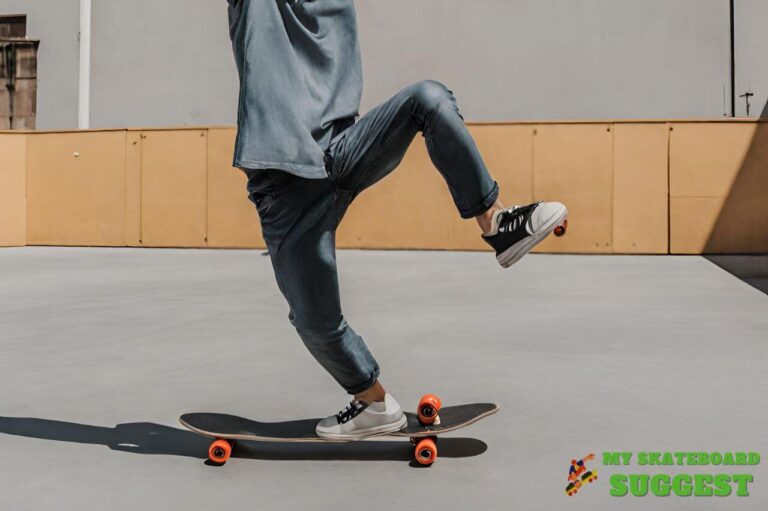Skateboarding isn’t just about rolling down the street; it’s an exhilarating dance between the rider and the board.
One of the fundamental skills every skateboarder must master is turning.
Whether you’re a beginner looking to navigate corners smoothly or an experienced skater aiming to perfect your carving and sliding techniques, this guide is your key to mastering the art of turning on a skateboard.
We’ll explore the techniques and tips to help you gracefully glide through curves, change directions with finesse, and take your skateboarding skills to the next level.
So, grab your board, and let’s dive into the world of turning on a skateboard.

Turning on a skateboard is essential for maneuvering and controlling your board.
There are a few techniques you can use to turn effectively on a skateboard:
Lean and Tilt:
This is the most basic way to turn.
To turn left, for example, lean your body to the left, and the skateboard will follow.
To turn right, lean to the right.
Make sure to keep your weight centered over the board for balance.
Carving:
Carving involves making broad and sweeping turns.
To carve, shift your weight slightly to one side and use your toes and heels to apply pressure to the edges of the board, causing it to turn.
This is an effective way to control your speed and make gentle turns.
Kicktail Turns:
If your skateboard has a kicktail (the upturned ends at the back), you can use it to make sharper turns.
Lift the front wheels slightly off the ground and pivot on the back wheels using the kicktail.
Push down with your front foot to initiate the turn.
This is often used for quick direction changes or sharp turns.
Kickturns:
Kickturns make 180-degree or sharper turns while keeping all four wheels on the ground.
Place more weight on your back foot to perform a kick turn and lift the front wheels.
Pivot on your back wheels while turning your shoulders and hips in the direction you want to go.
Once the turn is complete, place the front wheels back on the ground.
Sliding:
Sliding is an advanced technique used in downhill and freeride skateboarding.
It involves sliding the wheels on the ground to control speed and direction.
Sliding techniques like the Coleman slide, 180 slide, and stand-up slides are used to make sharp turns while sliding the wheels sideways.
Foot Placement:
Your foot placement can also affect your ability to turn.
Experiment with different foot positions to find what works best for you.
Having your front foot angled slightly toward the direction you want for basic turns can be helpful.
Practice:
Turning on a skateboard takes practice to understand how your board responds to your movements.
Start with gentle turns and work up to more advanced techniques as you become more comfortable.
Always wear safety gear, including a helmet, knee pads, elbow pads, and wrist guards, when skateboarding, especially when practicing new skills or attempting sharp turns.
Also, be aware of your surroundings, follow traffic rules, and skateboard in safe and designated areas.
FAQs
How do you turn and stop on a skateboard?
To turn on a skateboard, you can lean and tilt your body in the desired direction, use carving motions, make kicktail turns, or perform kick turns.
You can stop using foot braking, power sliding, or drag your foot on the ground.
How do you make a skateboard easier to turn?
Adjust your trucks (the metal parts that hold the wheels) to make a skateboard easier to turn by loosening the kingpin nut.
This allows for a more responsive turn. Additionally, softer bushings can make turning smoother.
How do you push and turn on a skateboard?
To push on a skateboard, use your rear foot to propel yourself while keeping your front foot on the board. To turn while pushing,
lean in the direction you want to go and use your body weight and slight pressure on the board’s edges to guide the turn.
In conclusion
In skateboarding, turning is the canvas upon which riders paint their unique style and creativity.
From the basics of leaning and carving to the advanced techniques of kick turns and sliding, turning on a skateboard is a skill that opens doors to endless possibilities.
As you’ve discovered in this guide, turning isn’t just about changing direction; it’s about mastering the synergy between your body and the board.
With practice, determination, and a dash of courage, you can transform simple turns into stylish maneuvers that leave your mark on the pavement.
Skateboarding is a journey of self-expression and adventure.
We hope this guide has empowered you with the knowledge and techniques needed to unlock the full potential of your skateboard.
Safety is paramount, so always ride responsibly and protect yourself with the right gear.
It’s time to take these newfound skills and embark on your unique skateboarding journey.
The streets, parks, and skateparks await your style, passion, and unforgettable turns.
So, grab your board, hit the pavement, and ride the wave of skateboarding mastery.
The world is your skatepark, and the possibilities are endless.
Enjoy the ride!


